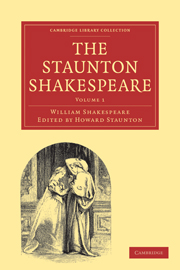Book contents
- Frontmatter
- Contents
- PREFACE
- SOME ACCOUNT OR THE LIFE OF SHAKESPEARE
- SHAKESPEARE'S WILL
- PRELIMINARY MATTER IN THE FOLIO OF 1623
- THE ADDRESS TO THE READER
- COMMENDATORY VERSES
- ADDENDA AND CORRIGENDA
- THE TWO GENTLEMEN OF VERONA
- LOVE'S LABOUR'S LOST
- THE COMEDY OF ERRORS
- ROMEO AND JULIET
- THE TAMING OF THE SHREW
- KING JOHN
- A MIDSUMMER NIGHT'S DREAM
- THE MERCHANT OF VENICE
- KING RICHARD THE SECOND
- THE FIRST PART OF KING HENRY THE FOURTH
- THE SECOND PART OF KING HENRY THE FOURTH
- THE MERRY WIVES OF WINDSOR
- MUCH ADO ABOUT NOTHING
ROMEO AND JULIET
Published online by Cambridge University Press: 29 August 2010
- Frontmatter
- Contents
- PREFACE
- SOME ACCOUNT OR THE LIFE OF SHAKESPEARE
- SHAKESPEARE'S WILL
- PRELIMINARY MATTER IN THE FOLIO OF 1623
- THE ADDRESS TO THE READER
- COMMENDATORY VERSES
- ADDENDA AND CORRIGENDA
- THE TWO GENTLEMEN OF VERONA
- LOVE'S LABOUR'S LOST
- THE COMEDY OF ERRORS
- ROMEO AND JULIET
- THE TAMING OF THE SHREW
- KING JOHN
- A MIDSUMMER NIGHT'S DREAM
- THE MERCHANT OF VENICE
- KING RICHARD THE SECOND
- THE FIRST PART OF KING HENRY THE FOURTH
- THE SECOND PART OF KING HENRY THE FOURTH
- THE MERRY WIVES OF WINDSOR
- MUCH ADO ABOUT NOTHING
Summary
The pathetic legend on which Shakespeare founded the plot of this beautiful tragedy has been cherished from time immemorial among the traditions of Italian history, although no such story has ever been discovered in the authentic records of any particular state. The Veronese, Lord Byron tells us, are tenacious to a degree of the truth of it, insisting on the fact, giving a date (1303), and showing the tomb. But this is only an instance of pardonable local vanity; no account exists of any actual Romeo and Juliet, but a tale more or less resembling that immortalized by our great dramatist may be found in several ancient writers. Mr. Douce has attempted to trace it to a Middle Greek author, one Xenophon Ephesius. The earliest writer, however, who set forth the romance in a connected narration is believed to be Masuccio di Salerno, in whose “Novellino,” a collection of tales first printed at Naples in 1476, a similar event is recorded to have occurred, not at Verona, but in Sienna. He relates that in Sienna there lived a young man of good family, named Mariotto Mignanelli, who was enamoured of a lady, Gianozza, and succeeded in engaging her affections; some impediment standing in the way of a public marriage, they are secretly united by an Augustine monk. Shortly after the ceremony, Mariotto has the misfortune to slay a fellow-citizen of rank in a street brawl, for which he is condemned by the Podesta to perpetual banishment.
- Type
- Chapter
- Information
- The Staunton Shakespeare , pp. 153 - 222Publisher: Cambridge University PressPrint publication year: 2009First published in: 1858

